
Depathologize Intersex
- About this Campaign
- What is the meaning of the term Pathologization? Is it the same as Medicalization?
- How is the current pathologizing paradigm impacting the health, access to health, and wellbeing of intersex people?
- What other aspects of pathologizing intersex bodies are there?
- How can we depath intersex?
- What else can you do?
- Other recommended resources
- Footnotes
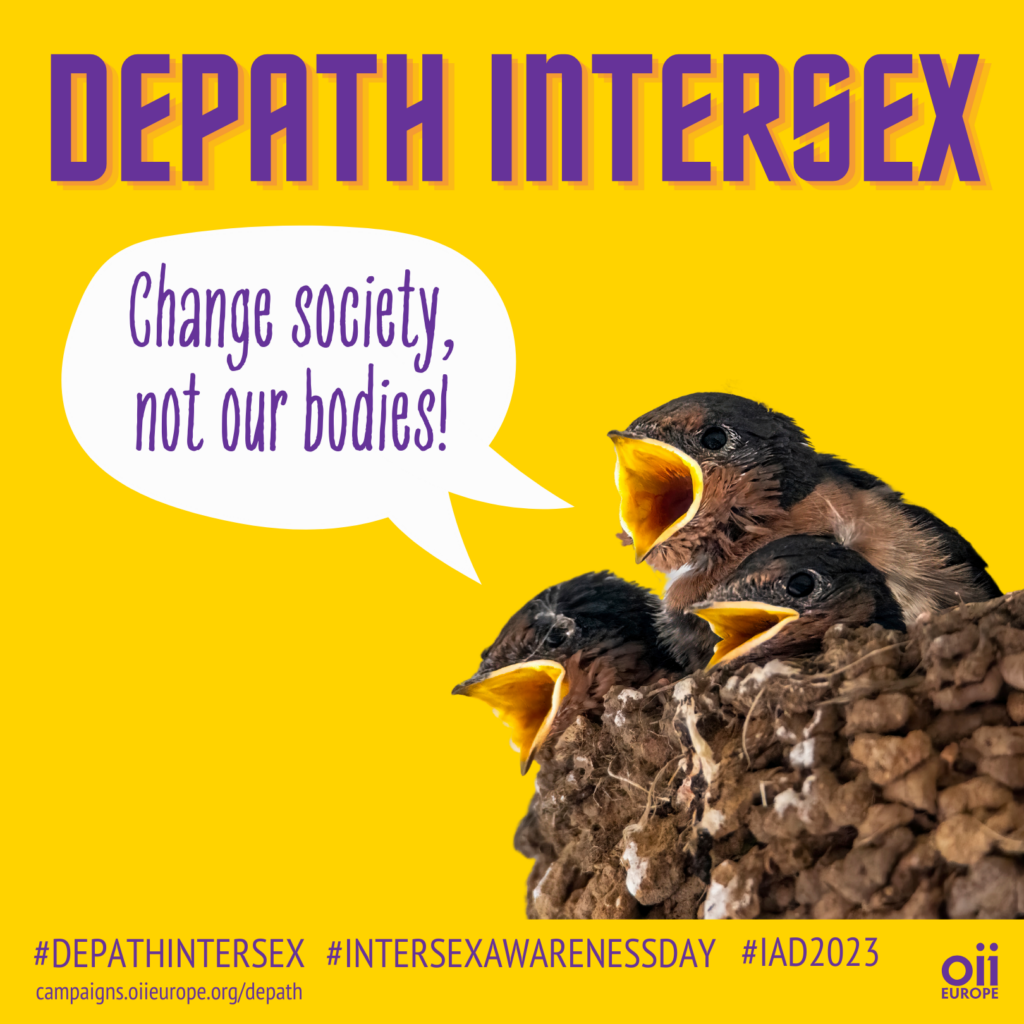
About this Campaign
With this 2023 Intersex Awareness Day Campaign we want to help people gain an understanding of what pathologizing intersex means, why it has to stop and how we can start depathologizing intersex. Pathologizing our intersex bodies has severely negative impacts on our lives and health and is one of the root causes of the human rights violations we face.

States have an obligation to investigate human rights violations and provide redress and remedies. States are also under an obligation to address the root causes of human rights violations, including by tackling stigma, pathologization, and harmful social and cultural norms.
Human Rights Violations Against Intersex People, A Background Note, United Nations Human Rights Office of the High Commissioner, 20191
It is worrying that the gap between the expectations of human rights organisations of intersex people and the development of medical classifications has possibly widened over the past decade. This raises serious questions with regard to the medical profession’s ability to help intersex people attain “the highest possible level of health” that they have a right to.
Council of Europe Commissioner for Human Rights, Human Rights and Intersex People, Issue Paper, 20152
What is the meaning of the term Pathologization? Is it the same as Medicalization?
The terms pathologization and medicalization are often used interchangeably, but they do have some subtle differences.
Pathologization
… is the interpretation of behaviours, sensations, perceptions, thoughts, social relationships, or interpersonal relationships as pathological, that is as “sick”, in “need to be fixed” or “treated”. Pathologization can be initiated and solidified by medical professionals, but also by individuals or society as a whole. On a social level, pathologization can be used to enforce what is considered “normal” vs. “abnormal”, creating and legitimising stigma and discrimination against those considered being “outside of the norm”.
The negative consequences of pathologization are often severe. However, in a societal climate that considers a certain physical and behavioural realities as non-normative and as such as defective, having one’s physical reality or behaviour being understood as a medical problem – and not as a problem of societal lack of acceptance and support – can sometimes be experienced as affirming, even liberating, “being seen as scientifically legitimated, since to see a condition as something gone awry in the body suggests that it can be changed rather than being an intractable part of one’s personality”.3
Medicalization
… is a term used to describe a process of social change in which human life experiences and areas of life become the focus of systematic medical research and responsibility that were previously outside the realm of medicine. Medicalization can lead to expecting, seeking and receiving medical treatment for issues that are not medical in nature. For example, the medicalization of childbirth has led to the increasing use of interventions such as epidurals and C-sections.
In other words, pathologization is the act of framing and generalising a given physical or behavioural reality as “sick”, “abnormal”, “disordered”, non-functional, in need of “fixing”, while medicalization is the process of expanding the scope of medicine to include physical or behavioural realities which were not treated as a medical problem before, through diagnoses, medical practices and research.
It is noteworthy that both pathologization and medicalization can simultaneously have positive and negative consequences. On one hand, they can lead to the development of new treatments and interventions that can improve people’s lives. Or on the other hand, they can lead to the overdiagnosis and overtreatment of people who do not actually have a medical problem.
In the case of intersex bodies and variations, both can be true as well: Some intersex people might have specific health needs that are directly related to their intersex variation, and therefore being able to access specific medical treatment(s) for curing an ailment would be beneficial.
But for many intersex persons the negative impacts of pathologization and medicalization are the more likely outcome and experience: They are subjected to harmful medical practices, especially but not limited to, surgeries that are irreversible, deferrable, non-vital interventions on healthy bodies. These interventions most often take place in infancy and childhood, and without their personal and fully informed consent. For intersex teenagers and adults too, pathologization continues to severely impact their access to healthcare negatively: as many doctors today might only be aware of the DSD nomenclature, it forces intersex people to disorder themselves to gain access to appropriate care.4 Also, acquired health issues or trauma by previous medical interventions earlier in life, or through continuous stigmatising and discriminatory medical services, all can lead to, among other things, avoidance of and/or exclusion from necessary treatments.
How is the current pathologizing paradigm impacting the health, access to health, and wellbeing of intersex people?
The ILGA-Europe & OII Europe publication “Intersections: Diving into the FRA LGBTI II Survey Data – Intersex Briefing” from 2023 elaborates on the existing analysis of the FRA LGBTI Survey II, including intersex persons’ experiences in relation to health, access to health and discrimination or mistreatment in healthcare settings:5
“Respondents were asked two questions related to their health status. Firstly, respondents ranked their health in general; in this question, intersex respondents assessed their health to be much poorer than the overall LGBTI respondents. Respondents also were asked to indicate if they had a long-term health problem or illness; 55.17% of intersex people indicated that they did, compared to 33.66% of all LGBTI respondents.”
“[…]Intersex people experienced much higher obstacles to health compared to LGBTI respondents, including difficulty gaining access, having their specific needs ignored, inappropriate curiosity or comments (28.99%), pressure to undergo treatment (19.22%), and avoidance of services (17.06%)”
The publication further highlights, that the exposure to mistreatment in healthcare settings includes the risk of sexual harassment, rape, verbal violence, derogatory comments, insults, refusal to perform needed examinations or examinations being carried out in violent ways or without the intersex person’s consent, or inappropriate curiosity or comments about their body.
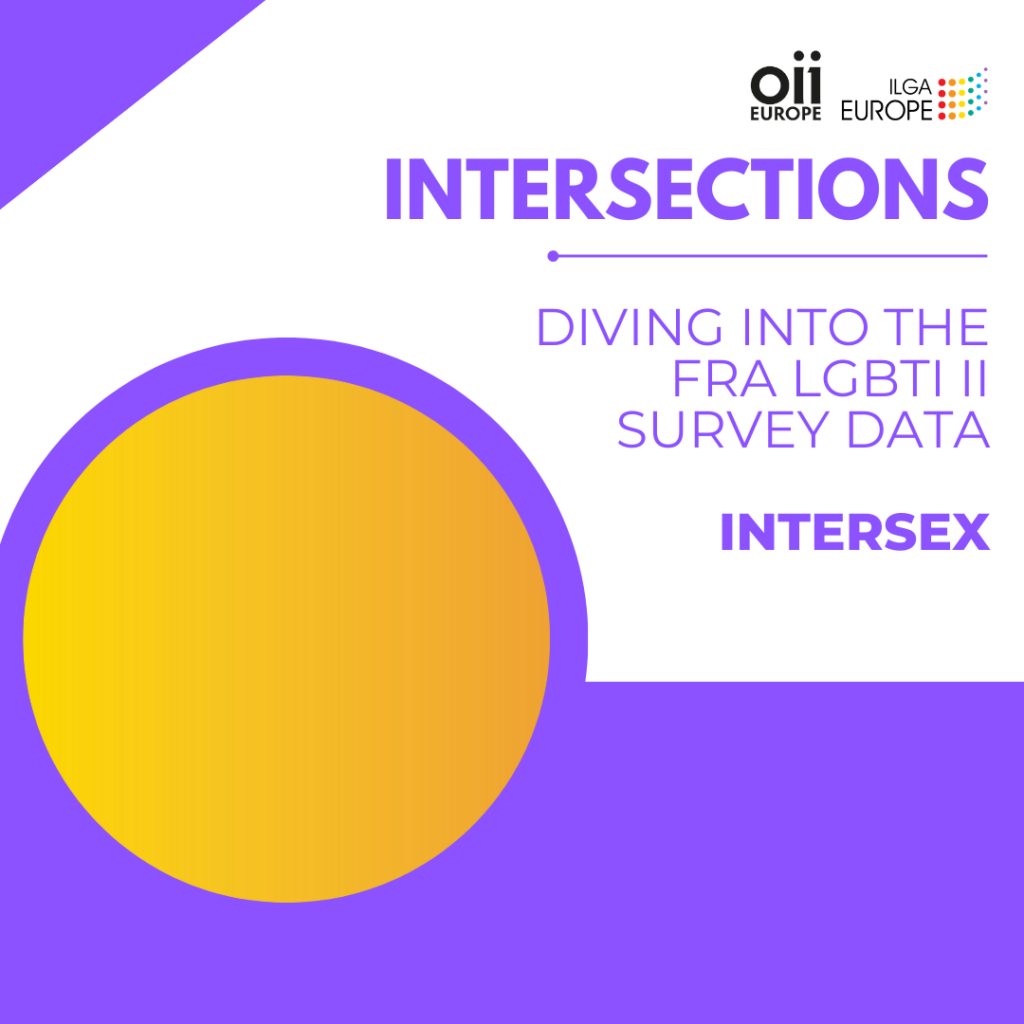

What other aspects of pathologizing intersex bodies are there?
While we have seen many great improvements and increased visibility towards intersex rights over the last decades, negative perceptions and attitudes viewing intersex as a disorder or as “abnormal” are still very common and continue to prevail in our society, which also continue to lead to human rights violations, including IGM. Sometimes these negative views present themselves as outright intersexphobia.
Intersexphobia exists: Intersexphobia, or interphobia, can be defined as a range of negative attitudes (e.g. emotional disgust, fear, violence, anger, or discomfort) felt or expressed towards people whose sex characteristics do not conform with society’s expectations of how the sex characteristics of a person, understood only as male or female, should look. Very often the same range of negative attitudes is also expressed towards the biological fact that sex is a spectrum, and that, therefore, variations of sex characteristics other than the male or female variations exist. The human rights violations intersex people face as a result of societal intersexphobia include, among others, pathologisation and genital mutilation (IGM).
Dan Christian Ghattas (2019): Protecting Intersex People in Europe. A toolkit for law and policy makers. With digital appendix and checklist. Ed. by ILGA-Europe and OII Europe.6
Medical model vs. social model: The common perception is that when a person’s body is not fitting the normative idea of male and female, this is considered as “having a disorder” and as something which is in need of “fixing” (medical model). This model persists in the latest revision of the WHO’s International Statistical Classification of Diseases and Related Health Problems (ICD), and attempts to depathologize the language within the ICD were disregarded.7 What the intersex human rights movement has been continuously saying, is that it is not our bodies that need “fixing” – it is the social concept of sex and gender, and its associated stereotypes that is required to change (social model).
National and international medical classifications which pathologise variations in sex characteristics should be reviewed with a view to eliminating obstacles to the effective enjoyment, by intersex persons, of human rights, including the right to the highest attainable standard of health.
Council of Europe Commissioner for Human Rights, Human Rights and Intersex People, Issue Paper, 20152

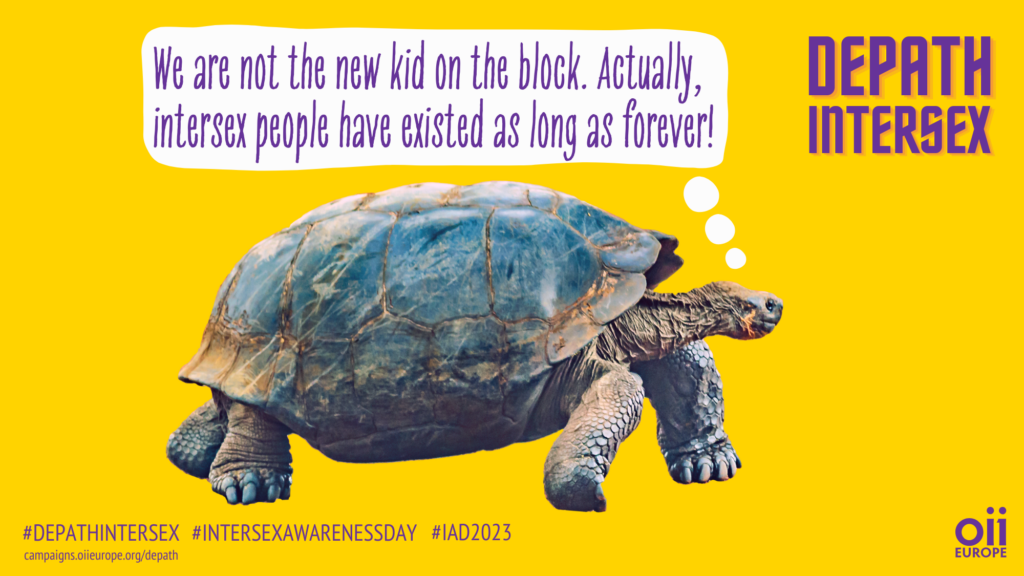
From “wonders and monsters”8 to “rare diseases”9: While intersex people have existed as long as there have been people, it is only with the emergence of medicine and following certain advances in medical technologies that bodies with innate variations of sex characteristics began to be explored as objects to describe and later to medically enforce a binary model of sex and gender upon. Pathologization of once so-called extraordinary bodies (which included persons with disabilities) has a long history, and became prevalent for intersex people by the second half of the previous century in the form of close-knit medical research and treatment.
How can we depath intersex?
An important beginning is a shift of perception: Intersex bodies are lovable just as everyone else’s. Being born with variations of sex characteristics is okay, is healthy, is beautiful. As a parent, having a child is a reason to celebrate and to love – this is just as true when having an intersex child. As with all children, we do not know how they will identify when they grow older, therefore as a society we should become less restrictive in our ideas about gender roles and duties.
This binary system might work for many, but not for all, and has been inflicting a lot of harm onto those not fitting into these boxes. For intersex people it has meant being systematically framed as disordered male and females in need of fixing in order to fit the binary boxes, through means that have been identified as harmful medical practices, torture and overall as serious human rights violations.

Multiple institutions including the Office of the United Nations High Commissioner for Human Rights, and UN and regional human rights mechanisms, have advised that States should, as a matter of urgency, protect the autonomy of intersex adults and children and their rights to health, to physical and mental integrity, to live free from violence and harmful practices and to be free from torture and ill-treatment.
Human Rights Violations Against Intersex People, A Background Note, United Nations Human Rights Office of the High Commissioner, 20191
We need to
- raise awareness of specific needs of intersex people in the medical context
- break social stereotypes
- raise awareness of specific needs of elderly intersex people
- review medical protocols and abolish discriminatory, pathologizing and stigmatising elements
- provide support structures for intersex persons and their families
…and much more:
National surveys as well as the UN shadow reports clearly show that intersex people lack protection of their right to health. In order to ensure intersex people’s enjoyment of their right to health, States should take measures to:
- protect people with variations of sex characteristics from non-emergency, invasive and irreversible “normalising” surgeries and other medical practices without the intersex individual’s personal and fully informed consent to end intersex genital mutilation (IGM) – please see also our IGM ban indicators below
as well as establish:
- the right to obtain treatment, including preventive check-ups and needed medication, which are based on the individual’s physical needs and are not limited by the sex/gender marker in their official documents.
- the right to lifelong coverage of any medication needed as a result of surgical and/or other interventions on the sex characteristics of a person by national health insurance reimbursement systems.
- the right to access to coverage that is not limited by the sex/gender marker in the person’s official documents, for any treatments.
- the right to expert-sensitive and individually tailored psychological and psycho-social counselling and support for all concerned individuals and their families, from the time of self-referral or diagnosis for as long as necessary.
- the right of survivors of intersex genital mutilation (IGM) to access reparative treatments on the same coverage terms as those provided for survivors of female genital mutilation (FGM).
- the right of access to one’s own complete medical records, including for minors.
as well as taking measures to:
- include human rights-based information about the existence of intersex people and about intersex issues in all medical curricula and other curricula in the area of health.
- establish obligatory training for medical professionals, such as doctors, midwives, psychologists and other professionals working in the health sector (e.g. reception desk staff), in order to ensure that intersex individuals and their families have access to adequate healthcare and are protected from discrimination. The training should include information about the vulnerability and special needs of intersex people in medical settings.
- establish obligatory, human rights-based training about the existence of intersex people and about the specific needs of intersex seniors for professionals working in elderly care to ensure that intersex seniors have access to adequate and respectful support and care without discrimination.
- invest in funding intersex groups and organisations so that they can engage in projects offering training for medical professionals, midwives, psychologists and other professionals working in the field of physical and mental health.
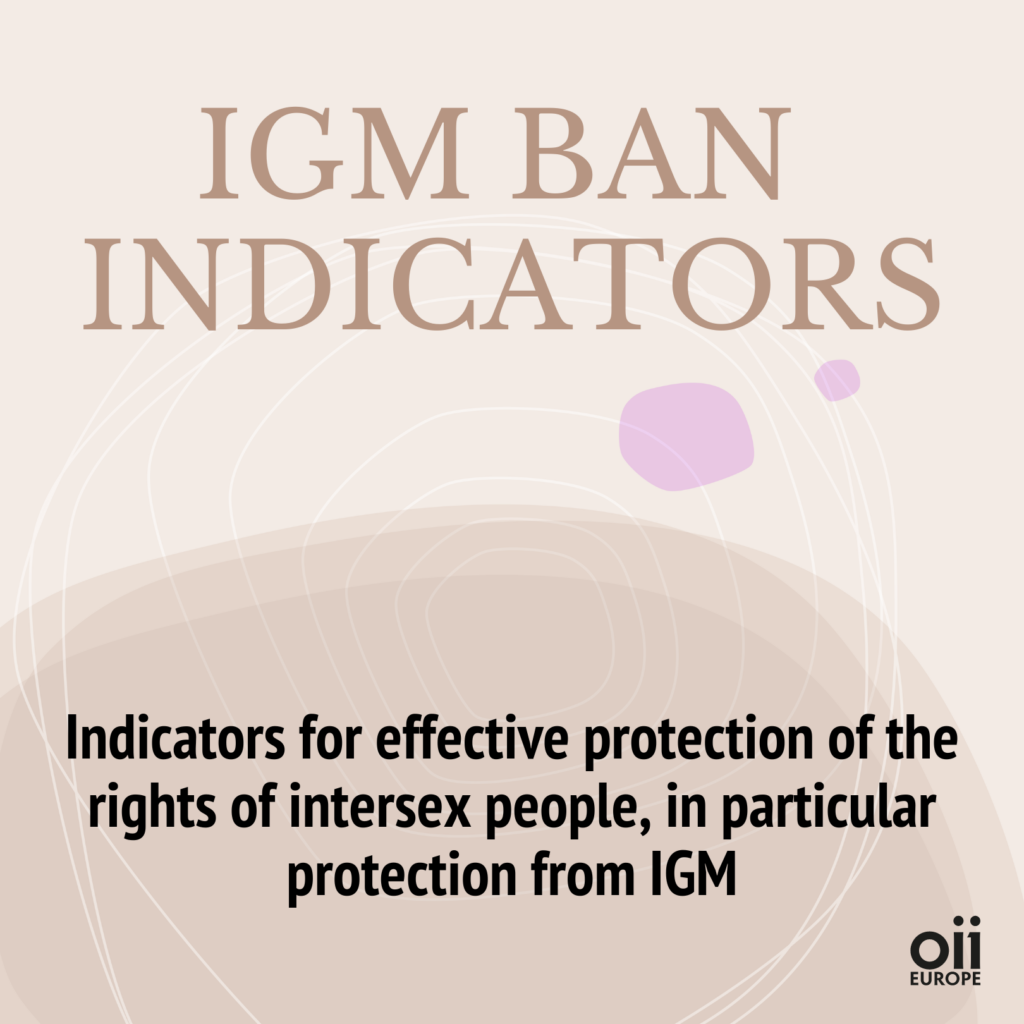
As a tool for policy and law makers OII Europe has prepared indicators for effective protection of the rights of intersex people, in particular protection from IGM to ensure
- legal protection of persons with a variation of sex characteristics from intersex genital mutilation
- effective implementation of such legal protection
- clarity and functionality of legislation prohibiting intersex genital mutilation
- access to truth, justice and reparations
- the right to health
- that a human rights based and de-pathologizing perspective on persons with a variation of sex characteristics is being mainstreamed among professionals
For further demands of the international intersex human rights movement, find out more about the international intersex fora in one of our previous IAD campaigns:
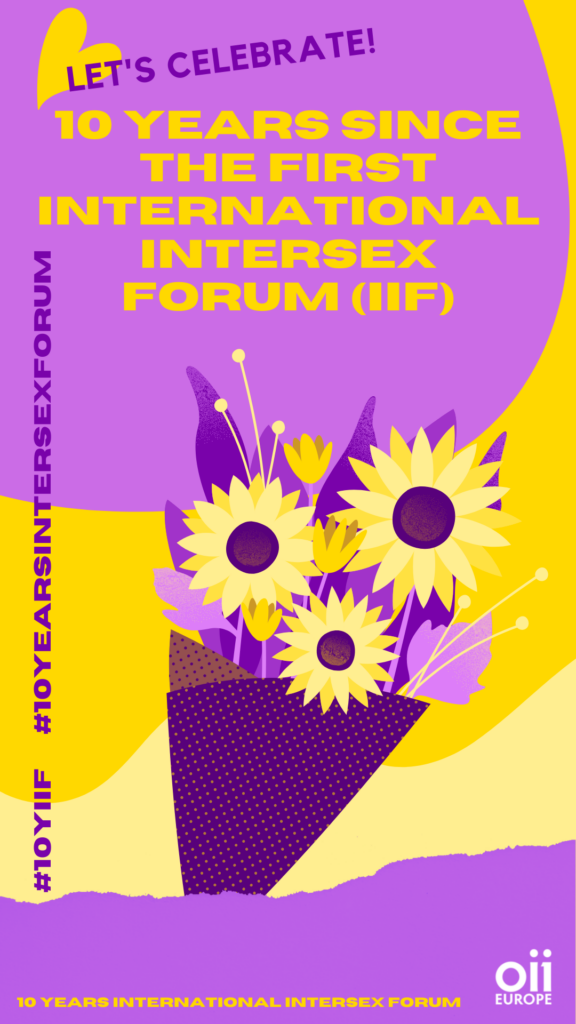
What else can you do?

You can share this or our previous campaigns and help raise awareness on intersex people and their rights! We have prepared a communication kit (google doc) that you can use for sharing this campaign in your networks and social media. We want to thank you for your support!
Ensuring the rights of intersex people of bodily integrity, physical autonomy and self-determination must be a priority in all action taken. Intersex people must be supported to be the drivers of social, political and legislative changes that concern them.
From the Statement of the 1st European Intersex Community Event Vienna, 201710
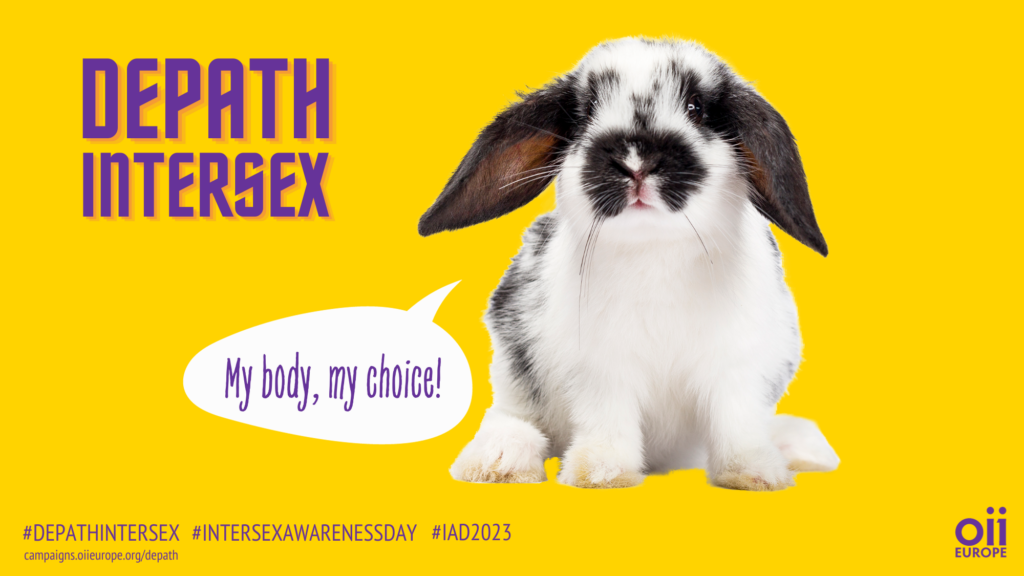
Other recommended resources
Here we would like to share some resources in regards to health reccommended by the European intersex community:
English
- What We Wish Our Doctors Knew, Interact (USA) brochure: Download Brochure (PDF)
- Intersex Variations Glossary, Interact (USA) brochure; People-centered definitions of intersex traits & variations in sex characteristics: Download Brochure (PDF)
- Healthcare and wellbeing pathways resources, Australian Intersex Community: link to external website
- Clinical guidelines, Intersex Human Rights Australia (IHRA) formerly OII Australia: link to external website
- Health of people with intersex variations, Victoria Department of Health – Australia: link to external website
- Intersex Depath – a project by IHRA: https://intersexdepath.org/
Deutsch
- INTER* – Hinweise für Ärzt_innen, Psycholog_innen, Therapeut_innen & andere medizinische Berufsgruppen, Brochure for health care providers, OII Germany & TrIQ (2013) Download Brochure (PDF)
- INTER* – Informationen für Ärzt_innen, Therapeut_innen & andere pflegende und medizinische Berufsgruppen, Brochure for health care providers, Vimö & TrIQ (2021) Download Brochure (PDF)
- Medizinische Eingriffe an Inter* und deren Folgen: Fakten und Erfahrungen, Medical interventions on intersex and their consequences, facts and experiences, German intersex testimonials, OII Germany & TrIQ (2017) link to external website
Française
- ENJEUX MÉDICAUX ET PS YCHOSOCIAUX POUR LES PATIENT·E·S INTERSEXES, Brochure for health care providers on intersex patients, CIA/OII France: link to external website
- DROITS DES PATIENT-E-S spécial personnes intersexes, Flyer for intersex patients on their rights (in France), CIA/OII France: Download Brochure (PDF)
A few thank you‘s for giving input and advice in creating this years campaign: The intersex community, especially the participants during the health workshop at the Community Event 2023 in Paris, France, E. Matthigack from OII Germany, and the whole OII Europe Team! THANK YOU!
Footnotes
- Background note Human Rights Violation against Intersex People (OHCHR), 2019 External link ↩︎
- Council of Europe Commissioner for Human Rights, Human Rights and Intersex People, Issue Paper, 2015 External link ↩︎
- Sholl J. The muddle of medicalization: pathologizing or medicalizing? Theor Med Bioeth. 2017 Aug;38(4):265-278. doi: 10.1007/s11017-017-9414-z. PMID: 28674861. ↩︎
- Demographics, 2016, IHRA link to external website ↩︎
- “Intersections: Diving into the FRA LGBTI II Survey Data – Intersex Briefing”, ILGA-Europe & OII Europe, 2023 ↩︎
- Dan Christian Ghattas (2019): Protecting Intersex People in Europe. A toolkit for law and policy makers. With digital appendix and checklist. Ed. by ILGA-Europe and OII Europe External link ↩︎
- GATE Submission to WHO on Intersex Issues in the process of ICD reform (2017) link to external website and Publication of joint ICD submission (2014) link to external website. See also: Carpenter M. Intersex Variations, Human Rights, and the International Classification of Diseases. Health Hum Rights. 2018 Dec;20(2):205-214. PMID: 30568414; PMCID: PMC6293350. ↩︎
- See for example “Wonders and the Order of Nature 1150–1750” by Lorraine Daston and Katharine Park ↩︎
- Clinical European study on the outcome of surgical and hormonal therapy and psychological intervention in disorders of sex development (DSD) link to external website ↩︎
- Statement of the 1st European Intersex Community Event, Vienna, 2017 External link ↩︎
